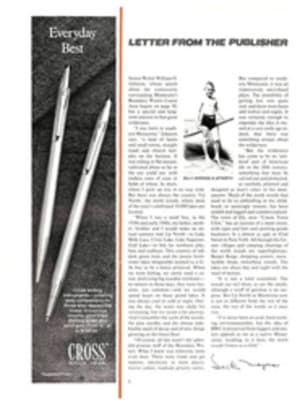
LETTER FROM THE PUBLISHER
Senior Writer William O. Johnson, whose article about the controversy surrounding Minnesota's Boundary Waters Canoe Area begins on page 50, has a special and long-term interest in that great wilderness.
"I was born in southern Minnesota," Johnson says, "a land of farms and small towns, straight roads and church steeples on the horizon. It was rolling or flat terrain, cultivated about as far as the eye could see, with endless rows of corn or fields of wheat. In short, where I grew up was in no way wild. But there was always the country 'Up North,' the north woods, where most of the state's celebrated 10,000 lakes are located.
"When I was a small boy, in the 1930s and early 1940s, my father, mother, brother and I would make an annual summer trek Up North—to Lake Mille Lacs, Cross Lake, Lake Superior, Gull Lake—to fish for northern pike, bass and walleyes. This country of tall, dark green trees and the purest freshwater lakes imaginable seemed to a little boy to be a forest primeval. When we went fishing, we rarely used a canoe, preferring big wooden rowboats—no motors in those days, they were luxuries, not common—and we would spend hours on those grand lakes. It was always cool or cold at night. During the day, the water was chilly for swimming, but we swam a lot anyway. And I remember the scent of the woods, the pine needles and the almost indefinable smell of decay and of new things growing on the forest floor.
"Of course, all this wasn't the splendid pristine stuff of the Boundary Waters. What I knew was relatively tame even then. There were roads and gas stations, electricity in most places, tourist cabins, roadside grocery stores. But compared to southern Minnesota, it was an impressively uncivilized place. The possibility of getting lost was quite real, and there were bears and wolves and eagles. It was certainly enough to engender the idea in me, and at a very early age indeed, that there was something unique about the wilderness.
"But the wilderness has come to be an 'artificial' part of American life in the 20th century, something that must be carved out and protected, as carefully planned and designed as man's cities or his monuments. Much of the north woods that used to be so enthralling in my childhood, so seemingly remote, has been settled and logged and commercialized. The town of Ely, now "Canoe Town USA," has an eyesore of a main street, with signs and bars and sporting-goods hucksters. It is almost as ugly as 42nd Street in New York. All through the former villages and camping clearings of the north woods are superhighways, Burger Kings, shopping centers, snowmobile shops, motorboat rentals. The lakes are abuzz day and night with the snarl of motors.
"It is not a total wasteland. The woods are still there, as are the smells, although a whiff of gasoline is no surprise. But Up North in Minnesota now is not as different from the rest of the state, the rest of the world, as it once was.
"I've never been an avid, hard-working environmentalist, but the idea of BWCA preserved from loggers and motors appeals to me as a native Minnesotan, recalling, as it does, the north woods I knew as a child."
PHOTO
BILLY JOHNSON, 8, UP NORTH

